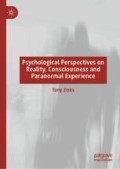Abstract
The second-path has a fine pedigree, since hallucinations have long been attributed to ghost sightings. In the early nineteenth century Sir Walter Scott discounted apparitions as illusions, but took the view that under certain circumstances the senses could become “deranged” and this provided a natural solution to why people reported seeing their “empty and false forms” and hearing their “idle sounds”.
Access this chapter
Tax calculation will be finalised at checkout
Purchases are for personal use only
Notes
- 1.
Inglis (1985/1986, p. 182).
- 2.
Dowben et al. (2017).
- 3.
Ibid., p. 220.
- 4.
Ibid.
- 5.
Akinci et al. (2016, p. 80).
- 6.
There’s no consideration that the patient was actually attacked by a legitimate poltergeist!
- 7.
Choong et al. (2007).
- 8.
Price (2016, p. 51).
- 9.
Parra (2015).
- 10.
Billock and Tsou (2012, p. 744).
- 11.
Ibid.
- 12.
Maher (1999, pp. 52–53).
- 13.
Ibid.
- 14.
Kosman and Silbersweig (2018).
- 15.
Gao et al. (2018).
- 16.
Lin et al. (2018).
- 17.
Arnulf (2013).
- 18.
Mobbs and Watt (2011).
- 19.
Arnulf (2013).
- 20.
Collerton et al. (2016, pp. 198–199).
- 21.
Dudley et al. (2018).
- 22.
Hirakawa et al. (2016, p. 10).
- 23.
Dudley et al. (2018).
- 24.
Foy (2011, pp. 362–363).
- 25.
Foy (2011, p. 363).
- 26.
Jinks (2016, p. 77).
- 27.
Evans (1984, p. 189).
- 28.
Ibid.
- 29.
Mobbs and Watt (2011).
- 30.
- 31.
Cancelli et al. (2004).
- 32.
Parra (2015).
- 33.
Collerton et al. (2005).
- 34.
Tyrell (1953).
References
Akinci, E., Oncu, F., & Topcular, B. (2016). Tactile Hallucination and Delusion Following Acute Stroke: A Case Report. Journal of Psychiatry & Neurological Sciences, 29(1), 79–84.
Arnulf, I. (2013). Dream Imagery, Rapid Eye Movement Sleep Behavior Disorder, and Hallucinations. Sleep and Biological Rhythms, 11(Suppl. 1), 15–20.
Billock, V. A., & Tsou, B. H. (2012). Elementary Visual Hallucinations and Their Relationships to Neural Pattern-Forming Mechanisms. Psychological Bulletin, 138(4), 744–774.
Cancelli, I., Marcon, G., & Balestrieri, M. (2004). Factors Associated with Complex Visual Hallucinations During Antidepressant Treatment. Human Psychopharmacology: Clinical & Experimental, 19(8), 577–584.
Choong, C., Hunter, M. D., & Woodruff, P. W. (2007). Auditory Hallucinations in Those Populations That Do Not Suffer from Schizophrenia. Current Psychiatry Reports, 9(3), 206–212.
Collerton, D., Perry, E., & McKeith, I. (2005). Why People See Things That Are Not There: A Novel Perception and Attention Deficit Model for Recurrent Complex Visual Hallucinations. Behavioral and Brain Sciences, 28(6), 737–757.
Collerton, D., Taylor, J.-P., Tsuda, I., Fujii, H., Nara, S., Aihara, K., et al. (2016). How Can We See Things That Are Not There? Current Insights into Complex Visual Hallucinations. Journal of Consciousness Studies, 23(7–8), 195–227.
Dowben, J. S., Kowalski, P. C., & Keltner, N. L. (2017). Formication, Tactile Hallucinations, Delusional Parasitosis, and Morgellons: Enough to Make Your Skin Crawl. Perspectives on Psychiatric Care, 53, 220–221.
Dudley, R., Aynsworth, C., Cheetham, R., McCarthy-Jones, S., & Collerton, D. (2018). Prevalence and Characteristics of Multi-modal Hallucinations in People with Psychosis Who Experience Visual Hallucinations. Psychiatry Research, 269, 25–30.
Evans, H. (1984). Visions, Apparitions, Alien Visitors. London: Book Club Associates.
Fish, W. (2005). Disjunctivism and Non-disjunctivism: Making Sense of the Debate. Proceedings of the Aristotelian Society, 105(1), 119–127.
Foy, K. (2011). Leprechauns and Lewy Body Disease. Transcultural Psychiatry, 48(3), 362–364.
Gao, X., Zhang, W., Yao, L., Xiao, Y., Liu, L., Liu, J., et al. (2018). Association Between Structural and Functional Brain Alterations in Drug-Free Patients with Schizophrenia: A Multimodal Meta-Analysis. Journal of Psychiatry and Neuroscience, 43(2), 131–142.
Haddock, A. (2011). The Disjunctive Conception of Perceiving. Philosophical Explorations, 14(1), 23–42.
Hirakawa, H., Terao, T., Kanehisa, M., Ninomiya, T., & Ishii, N. (2016). Coexistence of Delusional Parasitosis and Complex Visual Hallucinations with Micropsia. The Journal of Neuropsychiatry and Clinical Neurosciences, 28(1), e10–e12.
Inglis, B. (1985/1986). The Paranormal: An Encyclopedia of Psychic Phenomena. London: Paladin.
Jinks, A. (2016). The Disappearing Object Phenomenon: An Investigation. Jefferson, NC: McFarland.
Kosman, K. A., & Silbersweig, D. A. (2018). Pseudo-Charles Bonnet Syndrome with a Frontal Tumor: Visual Hallucinations, the Brain, and the Two-Hit Hypothesis. The Journal of Neuropsychiatry and Clinical Neurosciences, 30(1), 84–86.
Lin, W., Xie, Y.-C., Cheng, P.-Y., Dong, L.-Y., Hung, G.-U., & Chiu, P.-Y. (2018). Association of Visual Hallucinations with Very Mild Degenerative Dementia Due to Dementia with Lewy Bodies. PLoS ONE, 13(10), 1–8.
Maher, M. (1999). Riding the Waves in Search of the Particles: A Modern Study of Ghosts and Apparitions. Journal of Parapsychology, 63(1), 47–80.
Mobbs, D., & Watt, C. (2011). There Is Nothing Paranormal About Near-Death Experiences: How Neuroscience Can Explain Seeing Bright Lights, Meeting the Dead, or Being Convinced You Are One of Them. Trends in Cognitive Sciences, 15(10), 447–449.
Parra, A. (2015). Seeing Rare Things with the Mind’s Eye: Visual Imagery Vividness and Paranormal/Anomalous Experiences. Australian Journal of Parapsychology, 15(1), 37–51.
Price, B. (2016). Hallucinations: Insights and Supportive First Care. Nursing Standard, 30(21), 49–58.
Tyrell, G. N. M. (1953/1963). Apparitions. New York: Collier Books.
Author information
Authors and Affiliations
Corresponding author
Rights and permissions
Copyright information
© 2019 The Author(s)
About this chapter
Cite this chapter
Jinks, T. (2019). Hallucinations. In: Psychological Perspectives on Reality, Consciousness and Paranormal Experience. Palgrave Macmillan, Cham. https://doi.org/10.1007/978-3-030-28902-7_16
Download citation
DOI: https://doi.org/10.1007/978-3-030-28902-7_16
Published:
Publisher Name: Palgrave Macmillan, Cham
Print ISBN: 978-3-030-28901-0
Online ISBN: 978-3-030-28902-7
eBook Packages: Behavioral Science and PsychologyBehavioral Science and Psychology (R0)

